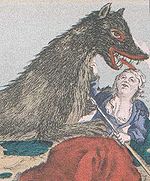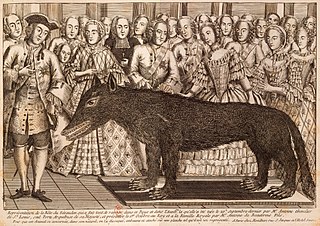Beast of Gévaudan
| (La bête du Gévaudan (French) La Bèstia de Gavaudan (Occitan) Wolf of Chazes Lycopardus parthenophagus[1]) | |
|---|---|
|
Artist's conception of one of the Beasts of Gévaudan, 18th-century engraving by A.F. of Alençon | |
| Creature | |
| Grouping | Wolves or wolf-dog crossbreds |
| Data | |
| First reported | 1764 |
| Country | |
| Region | Gévaudan (modern-day Lozère) |
The Beast of Gévaudan (French: La Bête du Gévaudan; IPA: [la bɜt dy ʒevɔdɑ̃], Occitan: La Bèstia de Gavaudan) is a name given to man-eating wolf-like animals alleged to have terrorized the former province of Gévaudan (modern day département of Lozère and part of Haute-Loire), in the Margeride Mountains in south-central France from 1764 to 1767 over an area stretching 90 by 80 kilometres (56 by 50 mi).[2] The beasts were consistently described by eyewitnesses as having formidable teeth and immense tails. Their fur had a reddish tinge, and was said to have emitted an unbearable odour. They killed their victims by tearing at their throats with their teeth. The number of victims differs according to source. De Beaufort (1987) estimated 210 attacks, resulting in 113 deaths and 49 injuries; 98 of the victims killed were partly eaten.[2] An enormous amount of manpower and resources was used in the hunting of the animals, including the army, conscripted civilians, several nobles, and a number of royal huntsmen.[2] All animals operated outside of ordinary wolf packs, though eyewitness accounts indicate that they sometimes were accompanied by a smaller female, which did not take part in the attacks. The story is a popular subject for cryptozoologists. Although several explanations have been put forward the exact identity of the creature remains unexplained to this day.
History
Attacks
The beast seemed to target humans over farm animals, many times attacking someone while cattle were in the same field.
The first attack that provided a description of one of the creatures took place on June 1, 1764. A woman from Langogne saw a large, lupine animal emerge from the trees and charge directly toward her, but it was driven away by the farm's bulls.
The first official victim of the beast, Jeanne Boulet, 14, was killed a month later, on June 30, near the village of Les Hubacs, not far from Langogne.
On January 12, 1765, Jacques Portefaix and seven friends, including two girls, were attacked by the Beast; they drove it away by staying grouped together. Their fight caught the attention of King Louis XV, who awarded 300 livres to Portefaix, and another 350 livres to be shared among the others. He also directed that Portefaix be educated at the state's expense. The King had taken a personal interest in the attacks, and sent professional wolf-hunters, Jean Charles Marc Antoine Vaumesle d'Enneval and his son Jean-François, to kill the beast. They arrived in Clermont-Ferrand on February 17, 1765, bringing with them eight bloodhounds which had been trained in wolf-hunting. They spent several months hunting wolves, believing them to be the beast. However, the attacks continued, and by June 1765 they were replaced by François Antoine (also wrongly named Antoine de Beauterne), the king's harquebus bearer and Lieutenant of the Hunt. He arrived in Le Malzieu on June 22.
On September 21, 1765, Antoine killed a large grey wolf measuring 80 centimetres (31 in) high, 1.7 m (5 ft 7 in) long, and weighing 60 kilograms (130 lb). The wolf was called Le Loup de Chazes, after the nearby Abbaye des Chazes. It was agreed locally that this was quite large for a wolf. Antoine officially stated: "We declare by the present report signed from our hand, we never saw a big wolf that could be compared to this one. Which is why we estimate this could be the fearsome beast that caused so much damage." The animal was further identified as the culprit by attack survivors, who recognized the scars on the creature's body, inflicted by victims defending themselves.[2] The wolf was stuffed and sent to Versailles where Antoine was received as a hero, receiving a large sum of money as well as titles and awards.
However, on December 2, 1765, another beast emerged in la Besseyre Saint Mary, severely injuring two children. Dozens more deaths are reported to have followed.
Death of the second beast
The killing of the creature that eventually marked the end of the attacks is credited to a local hunter, Jean Chastel, at the Sogne d'Auvers on June 19, 1767. Later novelists (Chevalley, 1936) introduced the idea that Chastel shot it with a blessed silver bullet of his own manufacture.[3] Upon being opened, the animal's stomach was shown to contain human remains.[2]
Controversy surrounds Chastel's account of his success. Family tradition claimed that, when part of a large hunting party, he sat down to read the Bible and pray. During one of the prayers the creature came into sight, staring at Chastel, who finished his prayer before shooting the beast. This would have been aberrant behavior for the beast, as it would usually attack on sight. Some believe this is proof Chastel participated with the beast, or even that he had trained it. However, the story of the prayer may simply have been invented out of religious or romantic motives.
Identity of the beasts
Various explanations were offered at the time of the attacks as to the beast's identity. Suggestions ranged from exaggerated accounts of wolf attacks, to a werewolf, all the way to the beast being a punishment from God. Jay M. Smith, in his book Monsters of the Gévaudan, suggests that the deaths attributed to the beast were more likely the work of a number of wolves or packs of wolves.[4]
Suggested species
Richard H. Thompson, author of Wolf-Hunting in France in the Reign of Louis XV: The Beast of the Gévaudan, contended that there can be satisfactory explanations based on large wolves for all the Beast's depredations.[5]
Another explanation is that the beasts were some type of domestic dog or crosses between wild wolves and domestic dogs, on account of their large size and unusual coloration.[2] This speculation has found support from naturalist Michel Louis, author of the book La bête du Gévaudan: L'innocence des loups (English: The Beast of Gévaudan: The innocence of wolves). Louis wrote that Jean Chastel was frequently seen with a large red coloured mastiff, which he believes sired the beast. He explains that the beast's resistance to bullets may have been due to it wearing the armoured hide of a young boar, thus also accounting for the unusual colour. He dismisses hyenas as culprits, as the beast itself had 42 teeth, while hyenas have 34.[6]
Certain cryptozoologists suggest that the beasts might be surviving remnants of a Mesonychid seeing how some witnesses described it as a huge wolf having hooves rather than paws and it was larger than any normal sized wolf,[7] whilst others still believe it was a hyena.
Article Source: http://en.wikipedia.org/
More Stories: http://blackboxmystery.blogspot.com/




No comments:
Post a Comment